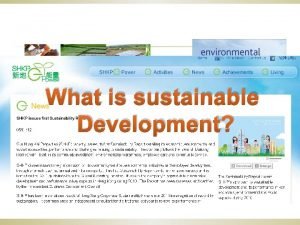South Africa Kate Nithya Amina Seana Geography the





















- Slides: 21

South Africa Kate, Nithya, Amina, Seana

Geography: the Great Escarpment Two major physiographic features: 1. Interior plateau 2. Land between the plateau and the coast Great Escarpment= steep boundary between these two areas

Population: Racial Distribution Black Population White Population Coloured Population

Population: Income Distribution

Colonial Era 1652 - 1948

Apartheid Era 1948 - 1994

Post-Apartheid Period 1994 - Today

Culture ● Multicultural ○ Rainbow Nation ● 11 languages ○ Zulu, Xhosa, Akrikaans, English ● Many religions ○ Dutch Reformed Church ○ Anglican Church ○ Zion Christian Church ○ Hinduism ○ Islam

Economy ● GDP: $368. 29 billion last year ● Top 1 percent of the population owns 70 percent of the nation’s wealth while the bottom 60 percent controls only 7 percent. ● Gini coefficient: 0. 73 ● 50% of South Africa’s population ○ ○ majority affected are black less than 1 percent of white South Africans live in poverty ● Extremely high unemployment rate: 29% ○ 46% of black South Africans unemployed ○ 9. 8% of white people are unemployed

Demographics ● Extremely young population: ○ Median age of 27 years ○ Approximately 28. 8% of the population under 15 years old ● 66. 9% of the population lives in an urban area

Demographic Transition Fertility: 6 (in 1950) (children per woman) 2. 6 (in 2019)

Epidemiologic Transition

Health Statistics ● ● ● Average life expectancy (2019) 64 years ○ male life expectancy around 61. 5 years ○ female life expectancy around 67 years. Infant mortality rate: of 35 deaths per 1, 000 live births (2019) Child mortality rate: 7 deaths per 1, 000 children (2019) Under-5 mortality rate (U 5 MR): 42 deaths per 1, 000 live births Maternal mortality ratio (MMR): 119 deaths per 100, 000 live births (2017) These are all well above the average for an upper middleincome country! Average Life Expectancy

Burden of Disease Adult HIV Prevalence

Health System and Health Programs ● Health as a human right ● 2 sectors: ○ ○ Public ■ overstaffed, under resourced Private→ serves only wealthy, small percentage of population. 9 physicians per 1000 people Uniform Patient Fee Schedule ● Primary Healthcare at the district level ○ ○ Hospitals Private Care ○ $17 billion to implement by 2022 ● National Health Insurance → Universal Healthcare ● National Development Plan and National Strategic Plan

Health Priorities: 1. HIV/AIDs Crisis a. Pr. EP b. Antiretroviral Treatment: (ART) 2. Addressing Racial Inequality a. National Health Insurance (NHI) b. National Strategic Plan

Health Priorities: Tackling HIV/AIDS

Trends and Expected Future Trends ● Decreasing poverty rates ○ Becoming stagnant ● Increased non-communicable disease in rural areas ● Increased access to HIV/AIDS treatment ● Increase of physicians in the private sector and not public sector ● Decreasing emigration of healthcare and skilled workers

Recommendations ● Strengthen primary health care, especially in rural areas ○ Why? To address rising NC disease rates and enforce preventative measure to health ● Accelerate GDP growth ○ Invest in education and job training ● Address inequality through wealth tax, and use that funding to help fund NHI

References World Bank Indicators. (n. d. ). Retrieved from https: //data. worldbank. org/indicator. Statistics South Africa. (n. d. ). The South Africa I Know, The Home I Understand. Retrieved November 4, 2019, from http: //www. statssa. gov. za/ Institute for Health Metrics and Evaluation. (2017, September 19). South Africa. Retrieved from http: //www. healthdata. org/southafrica.

Questions?
 N metil propilamina
N metil propilamina Anxilytic
Anxilytic Kate del castillo kate trillo del castillo
Kate del castillo kate trillo del castillo Erratic
Erratic Open shaft diamond mining at kimberley south africa in 1872
Open shaft diamond mining at kimberley south africa in 1872 Vetasi south africa
Vetasi south africa Rx24 price in south africa
Rx24 price in south africa Political map of north africa and southwest asia
Political map of north africa and southwest asia Bibliography of drought in south africa
Bibliography of drought in south africa Wasa south africa
Wasa south africa Neuropsychology in south africa
Neuropsychology in south africa Bamboo globalization south africa
Bamboo globalization south africa Military social work in south africa
Military social work in south africa Safi south africa
Safi south africa Blue deal south africa
Blue deal south africa 115753 memorandum
115753 memorandum Antenatal card format
Antenatal card format Apartheid south africa
Apartheid south africa Reflectix, inc.
Reflectix, inc. Did the dutch colonize south africa
Did the dutch colonize south africa Causes of unemployment in south africa
Causes of unemployment in south africa S8610u ignition module
S8610u ignition module









































